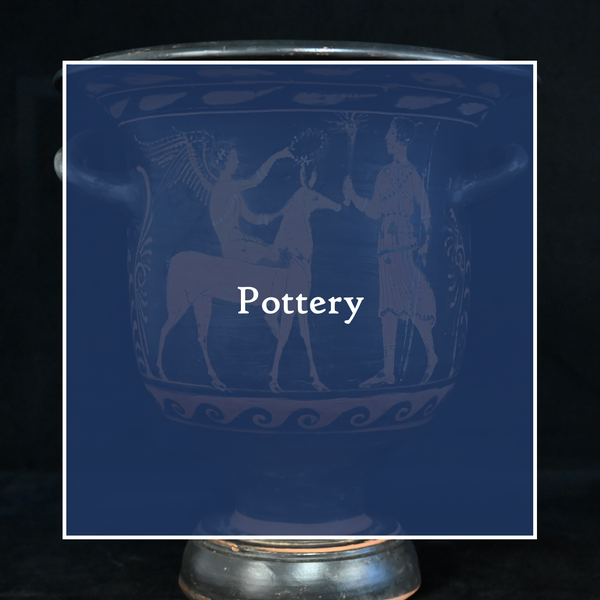Pottery
|
Pottery is an important type of find in archaeology. Since pottery has a relatively short period of use but serves a variety of functions, it was mass-produced in antiquity. Additionally, preferences regarding the shapes and types of vessels changed frequently, making it easy to classify different forms chronologically. Figuratively decorated vessels also provide insights into the norms and values of ancient societies.
Black-Figure Style The black-figure technique was developed in Corinth around 700 BC and adopted by Attic potters from 630 BC, with Athens perfecting it. In this technique, figures and ornaments are applied to the vessel using a fine, diluted clay slip. Details on the faces, bodies, or garments of the figures are incised before firing. Red-Figure Style Around 530 BC, the red-figure technique was developed in Athens. In this method, figures and ornaments are left unpainted, while the entire background is covered with clay slip. Details, such as folds in garments, are indicated by fine lines applied with a brush. After firing, the figures in the red-figure style stand out against the black background. The red-figure and black-figure techniques coexisted for a time, but the red-figure technique largely replaced the black-figure style around the turn of the 6th to 5th century BC. |
|
|
White-Ground Technique The white-ground technique was developed around 530/520 BC and was used alongside black-figure and red-figure vase painting. This technique involves applying a characteristic white coating to the vases using a clay slip containing kaolinite. Figures were then outlined and painted on the surface, with non-mineral colors such as red or blue used for details like clothing. Due to the relatively delicate surface and the poor durability of the colors, white-ground vases were not suitable for everyday use. Instead, they were primarily used as votive offerings and in funerary contexts. The scenes depicted on these vases often include representations of women’s daily life and funerary rituals. From around 430 BC, the technique was predominantly used on lekyths and gradually fell out of favor by around 400 BC.
|
Black-Glazed Ware By the 4th century BC, the production of figuratively decorated pottery ceased at most production sites. Instead, a new style of pottery became fashionable, characterized by a body completely covered in black glaze. Decorative elements were now mostly limited to painted ornaments, such as vines and other floral motifs, in red or white. Notable examples of this black-glazed pottery are found in "Gnathia pottery," named after its place of discovery, Egnazia, in Apulia. Less commonly, figures are also depicted on these vessels. |
|
Relief Pottery At the end of the 3rd century BC, around 240 BC, a new manufacturing technique emerged that allowed for the series production of vessels, leading to their rapid spread throughout the Mediterranean region. This type of pottery, known as relief pottery, was no longer made on the potter's wheel but was produced using prefabricated molds. The process began with creating a negative mold on the potter's wheel, into which decorations were pressed using stamps or punches. This mold was then fired. In the second step, clay was pressed into the fired mold. The decorations appeared as embossed relief on the finished vessel. Because the mold was reusable, this technique enabled the quick and efficient mass production of uniform vessels. Famous Hellenistic examples of this type include the "Megaric cups," which are hemispherical drinking vessels with a brown to black coating and floral relief decoration. These cups are named after Megara, one of the places where they were found, near Athens. Other production centers were located in eastern Greece, the Black Sea region, and Asia Minor.
|
Terra Sigillata In Roman times, the technique of producing vessels using molds was perfected, making Roman terra sigillata a major export of the ancient world. The vessels were dipped in a liquid, ferruginous clay slip while still leather-hard, and then fired at temperatures exceeding 900 degrees Celsius. Other decoration techniques included applying relief appliqués, using the barbotine technique (where thick clay slip is used to create decorations on the vessel's surface), and incising decorations. Roman terra sigillata production began around 40 BC in Arretium (modern-day Arezzo), modeled after Hellenistic relief pottery. By the 2nd century AD, this pottery style had spread throughout the Mediterranean region and was also produced in North Africa. In present-day Germany, significant production centers were located in Trier (ancient Augusta Treverorum) and Rheinzabern (ancient Tabernae). |

